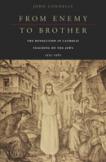Family Therapy
The appalling crimes of National Socialism against 6 million Jews,” Augustin Cardinal Bea wrote to Pope John XXIII 50 years ago, require a “purification of spirit and conscience,” on the part of the Catholic Church. For Bea, the driving issue was one of religious solidarity. “The bond of kinship between Christians and Jews,” goes “far deeper than the bond which unites all humans.” Bea’s diction, his instincts, his sensitivities and his willpower all came to focus on forging a document that three years later would become the landmark declaration of the Second Vatican Council, the “Declaration on the Relationship of the Church to Non-Christian Religions.”
As the church begins to celebrate the rich contributions of the Second Vatican Council, the language employed by Cardinal Bea seems almost routine and inherently sensible. But what John Connelly points out in his new and excellent book, From Enemy to Brother, is that Cardinal Bea’s instincts emerged out of a decades-long struggle between an impassioned minority within the church and the hierarchs, lower clergy and ordinary Catholics who stridently and with equal “instincts” opposed the council’s move toward connecting with the Jewish people in a new and heretofore radical way.
Connelly makes a number of bold moves in telling his story of the theological journey from Catholic demonization of Jews to a common bond of solidarity. First, he does not rush to judgment about Catholic participation in anti-Semitism, but rather sets a more complex backdrop through his discussion of Catholic racism. Connelly shows that during the 1920s, influential teachers, including Hermann Muckermann, S.J., in Berlin, were arguing that Catholics should hold as a religious priority the need to “protect the race” from Jewish infiltration. With Muckermann and other German theorists showing the way, the belief that baptism remitted original sin and actual guilt became muddled with skepticism about whether the “genetic traits” of Jews with “the stain of having killed God” could be equally remitted. As Connelly has put it, “science offered a cloak that fit the contours...of prejudices.” Race science was beginning to undercut sacramental theology.
Many who read Connelly’s book will come away with the idea that it was a core group of Jewish converts to Catholicism who spearheaded and revolutionized Catholic teaching on the Jews. Largely unstated is the fact that a significant number of Catholic converts from Protestantism, like Karl Thieme (Lutheran), Jacques Maritain (French Reformed) and Dietrich von Hildebrand (baptized Protestant) were the ones who were often pushing and persuading their Jewish-convert colleagues to adopt positions that were first sparked by their own Protestant sensibilities.
When various hierarchs and cardinals began searching for a postwar interreligious dialogue of understanding, they naturally highlighted the writings and opinions of Jews who had converted to Catholicism. But as the institutional church looked in this direction, it was really the profound biblical scholarship of converts from Protestantism that provided courage for their Jewish comrades. The Jewish converts then kept the conversation moving in a direction that would lead to the council’s declaration.
For Connelly, the leader of this group was Johannes (John) Oesterreicher. A Moravian Jew whose conversion took many years, Oesterreicher was ordained a priest in 1927 and arrived in the United States from France in 1940. A vigorous anti-Nazi, Oesterreicher was consumed with reconciling Catholics and Jews. His story provides a leitmotif as Connelly unpacks the larger theological stresses and shadows associated with the circle of Jewish converts looking to crack the façade of Catholic anti-Semitism and anti-Judaism.
During his early years as a priest, and before he established the Institute of Judeo-Christian Studies at Seton Hall University in New Jersey, two forces emerged that caused Oesterreicher doubt and disillusion. The first was the nagging issue of race. Even after his ordination as a priest, the preaching of a prominent Jesuit that Jewish converts “were not equal to Aryans because of bad genetic material” precipitated not only personal doubt, but cut to the core of Oesterreicher’s emerging theology, which was grounded in human solidarity.
In addition, the zealousness of his own conversion compelled Oesterreicher to pursue a ministry precisely aimed at the conversion of Jews to the Roman Catholic Church. This was a common custom supported by Tridentine theology, but it greatly handicapped his ability to work with others in the maturing interreligious movement. After Auschwitz (both of Oesterreicher’s parents died in concentration camps, his mother at Auschwitz), the small circle who supported Catholic-Jewish relations was beginning to embrace the position that Jews were not in need of conversion at all. This “ecumenical” approach began to change the trajectory of the movement and was grounded in the scriptural reflections of Oesterreicher’s fellow (former Protestant) converts.
Toward the end of Connelly’s book, the notion of “conversion” returns to an initial theme that Connelly calls “border-crossing.” “Border-crossers” like Oesterreicher operated on a front line of shared contact between the religions. It was this shared area of contact that became the seedbed of growth for the council’s “Declaration on the Relationship of the Church to Non-Christian Religions.”
Connelly’s book is important because for the first time we have a comprehensive tale of the genesis of a new teaching. This is a book about workers in the vineyard who have largely been overlooked or bypassed in church history. But it is to these workers, who rose before dawn, that the church owes profound, if belated, respect.
This article also appeared in print, under the headline “Family Therapy,” in the October 8, 2012, issue.








